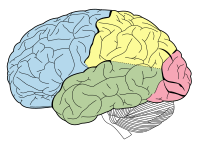
Applying fuzzy decision for a single channel SSVEP-based BCI on automatic feeding robot
Sign Up to like & getrecommendations! Published in 2018 at "Microsystem Technologies"
DOI: 10.1007/s00542-016-3229-0
Abstract: An application of steady state evoked potential (SSVEP) based brain–computer interface (BCI) has been developed by implementing the fuzzy decision model for the automatic feeding robot. Four blinking boxes were displayed on the corner of… read more here.
Keywords: based bci; fuzzy decision; ssvep based; automatic feeding ... See more keywords

An approach for brain-controlled prostheses based on Scene Graph Steady-State Visual Evoked Potentials
Sign Up to like & getrecommendations! Published in 2018 at "Brain Research"
DOI: 10.1016/j.brainres.2018.05.018
Abstract: Brain control technology can restore communication between the brain and a prosthesis, and choosing a Brain-Computer Interface (BCI) paradigm to evoke electroencephalogram (EEG) signals is an essential step for developing this technology. In this paper,… read more here.
Keywords: scene graph; brain; ssvep; system ... See more keywords

Periodic component analysis as a spatial filter for SSVEP-based brain–computer interface
Sign Up to like & getrecommendations! Published in 2018 at "Journal of Neuroscience Methods"
DOI: 10.1016/j.jneumeth.2018.06.003
Abstract: Abstract Background Traditional spatial filters used for steady-state visual evoked potential (SSVEP) extraction such as minimum energy combination (MEC) require the estimation of the background electroencephalogram (EEG) noise components. Even though this leads to improved… read more here.
Keywords: ssvep based; analysis; periodic component; ssvep ... See more keywords

An online SSVEP-BCI system in an optical see-through augmented reality environment.
Sign Up to like & getrecommendations! Published in 2019 at "Journal of neural engineering"
DOI: 10.1088/1741-2552/ab4dc6
Abstract: OBJECTIVE This study aimed to design and evaluate a high-speed online steady-state visually evoked potential (SSVEP)-based brain-computer interface (BCI) in an optical see-through (OST) augmented reality (AR) environment. APPROACH An eight-class BCI was designed in… read more here.
Keywords: augmented reality; optical see; bci; online ... See more keywords

Multi-scale noise transfer and feature frequency detection in SSVEP based on FitzHugh–Nagumo neuron system
Sign Up to like & getrecommendations! Published in 2021 at "Journal of Neural Engineering"
DOI: 10.1088/1741-2552/ac2bb7
Abstract: Objective. The steady-state visual evoked potential (SSVEP) is one of the most commonly used control signals for brain–computer interfaces (BCIs) due to its excellent interactive potential, such as high tolerance to noises and robust performance… read more here.
Keywords: frequency; neuron; noise; multi scale ... See more keywords

The effect of stimulus number on the recognition accuracy and information transfer rate of SSVEP–BCI in augmented reality
Sign Up to like & getrecommendations! Published in 2022 at "Journal of Neural Engineering"
DOI: 10.1088/1741-2552/ac6ae5
Abstract: Objective. The biggest advantage of steady-state visual evoked potential (SSVEP)-based brain–computer interface (BCI) lies in its large command set and high information transfer rate (ITR). Almost all current SSVEP–BCIs use a computer screen (CS) to… read more here.
Keywords: recognition accuracy; ssvep bci; ssvep; stimulus number ... See more keywords

Cross-subject spatial filter transfer method for SSVEP-EEG feature recognition
Sign Up to like & getrecommendations! Published in 2022 at "Journal of Neural Engineering"
DOI: 10.1088/1741-2552/ac6b57
Abstract: Objective. Steady-state visual evoked potential (SSVEP) is an important control method of the brain–computer interface (BCI) system. The development of an efficient SSVEP feature decoding algorithm is the core issue in SSVEP-BCI. It has been… read more here.
Keywords: feature recognition; transfer; feature; method ... See more keywords

Threshold Determination Criterion in Steady-State Visual Evoked Potential-Based Acuity Assessment: A Comparison of Four Common Methods
Sign Up to like & getrecommendations! Published in 2020 at "IEEE Access"
DOI: 10.1109/access.2020.3032129
Abstract: The steady-state visual evoked potential (SSVEP) visual acuity is usually defined by extrapolating a straight line regressed through significant SSVEP amplitudes plotted versus spatial frequencies to $0~\mu \text{V}$ or a noise level floor, or the… read more here.
Keywords: extrapolation; visual acuity; steady state; determination ... See more keywords

Stimulus-Stimulus Transfer Based on Time-Frequency-Joint Representation in SSVEP-Based BCIs
Sign Up to like & getrecommendations! Published in 2022 at "IEEE Transactions on Biomedical Engineering"
DOI: 10.1109/tbme.2022.3198639
Abstract: Objective: Brain-computer interfaces (BCIs) based on steady-state visual evoked potential (SSVEP) require extensive and costly calibration to achieve high performance. Using transfer learning to re-use existing calibration data from old stimuli is a promising strategy,… read more here.
Keywords: time; stimulus transfer; stimulus stimulus; stimulus ... See more keywords

Adaptive Window Method Based on FBCCA for Optimal SSVEP Recognition
Sign Up to like & getrecommendations! Published in 2022 at "IEEE Transactions on Neural Systems and Rehabilitation Engineering"
DOI: 10.1109/tnsre.2022.3217789
Abstract: In the conventional studies related to steady-state visual evoked potential (SSVEP)-based brain-computer interfaces (BCIs), the window length (detection time) was typically predetermined through the offline analysis, which had limitations of practical applicability of a BCI… read more here.
Keywords: window length; adaptive window; method; window ... See more keywords

A Novel SSVEP Brain-Computer Interface System Based on Simultaneous Modulation of Luminance and Motion
Sign Up to like & getrecommendations! Published in 2023 at "IEEE Transactions on Neural Systems and Rehabilitation Engineering"
DOI: 10.1109/tnsre.2023.3241629
Abstract: Steady-state visual evoked potential (SSVEP)-based brain-computer interfaces (BCIs) have received significant attention owing to their high information transfer rate (ITR) and low training requirements. Previous SSVEP-based BCIs mostly adopt the stationary visual flickers where only… read more here.
Keywords: luminance; system; modulation; brain computer ... See more keywords